2011 Sea-Doo RXT-X aS 260 Review
Sea-Doo Goes After Offshore Performance Enthusiasts With Unique, Adjustable-Suspension RXT-X
Not content to let Kawasaki steal all those big-water enthusiasts, Sea-Doo has responded for 2011 with an ocean-going kingpin of its own, the RXT-X aS 260. Using a unique adjustable suspension, it allows users to dial in the ride for the biggest of conditions, all while offering all the engine that Sea-Doo has to offer.
Will this big, powerful machine challenge Kawasaki’s dominance in offshore circles? Read on.
On The Rebound
By now, most PWC enthusiasts are familiar with Sea-Doo’s standard Intelligent Suspension (iS) system. By allowing the complete rider area — seat, handlebars, and even footwells — to move independently of the upper deck, Sea-Doo has sought to smoothen out the ride in rough water. The two primary components are linked via pivoting aluminum arms fore and aft; a coil spring and gas shock handles the suspension load. The craft’s iControl computer determines the correct amount of preload for the spring.
What makes the aS unique from its iS counterpart is that the operator can now further fine-tune the suspension’s stiffness for really big conditions. Manual adjustments to the system are possible via a trick-looking nitrogen-charged, remote oil reservoir located within the glovebox, clearly visible through a clear panel in the hatch for that custom look. Turn the knob attached to the cylinder in one
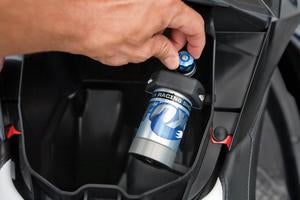 The aS suspension system can be fine-tuned by turning a knob in the glovebox.
The aS suspension system can be fine-tuned by turning a knob in the glovebox.direction and the suspension stiffens; turn it the opposite and it gets a little cushier. In stock form, the aS suspension is calibrated at the factory for what Sea-Doo says are 2’-5’ wave conditions, and provides anywhere from 65-115% more compression dampening than the standard suspension-equipped RXT iS. If desired, owners can manually increase the suspension’s preload further by accessing an adjustment screw under the craft’s seat.
My test of the RXT aS happened on stretches of Intracoastal Waterway, not in the ocean waves it’s designed for. Still, I was able to find enough waves and chop to get a feel for the different settings. Basically a stiffer suspension eliminates that “springy” effect you can feel with a suspension in rougher conditions. Stiffened up, the suspension doesn’t rebound quite so energetically, eliminating some of the bouncy feeling previous suspension models suffered in larger ocean conditions, and preventing the top deck from “bottoming out” against the hull when coming off larger waves. That will be good news to the racers Sea-Doo seems to be targeting. Long-distance offshore types will now find the boat a compelling alternative to Kawasaki’s Ultra models. It will also, however, be a hot ticket for those offshore enthusiasts who just like to play, or travel, along the coastlines.
Race-Ready
Like previous RXT-X models, there’s more race-inspired goodies to be found on the aS 260. For one, there’s more race-inspired data included in the info display, like a lap timer, average speed, and time and distance-to-empty readouts. You also get a lower profile seat that allows a rider to throw their weight around to gain leverage. More practical items include Sea-Doo’s High-Performance VTS, a variable trim system that adjusts quickly on the fly and offers presets that can be reached with a double-tap of the button
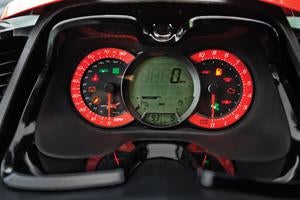 The aS 260’s racing-inspired display offers information such as lap times and average speed.
The aS 260’s racing-inspired display offers information such as lap times and average speed.so that your focus can remain on the water ahead. The boat’s X-Steering is also a winner; it’s not only a cool design, but it also can be adjusted in both handlebar width and even grip angle, allowing the driver to really customize the boat to fit his size and ride style.
One minimal gripe? The storage is also “race-inspired.” In short, it’s puny by today’s standards, a minimal 16.4 gallons, but then again, buyers of this boat probably aren’t concerned with what they can bring along for the ride beyond the most basic necessities.
That leaves the standout features the one-two punch of braking and electronic throttle control. Racers may not demand brakes, but Sea-Doo gives them the choice anyway. I like that I can rapidly slow the boat down when desired, and several of Sea-Doo’s racers have now confided to me they actually have used the system to set up for a buoy. Brakes work by interrupting the flow of water to the pump for a milli-second, then dropping a reinforced reverse bucket in varying stages before reapplying thrust. The redirected flow of water rapidly slows the craft, while the iControl computer avoids that braking come on so strong as to toss the rider over the handlebars at speed. I still like the system for the simplest reasons. It allows the boat to start in a neutral mode at the dock, and then be “shifted” into forward or reverse with the handlebar-mounted throttle or reverse lever. That may not be racy, but it’s superior control to anything else out there.
Electronic throttle eliminates a mechanical cable, but also allows the craft to offer a gentler “touring mode” for those that want the full brunt of the engine, or “sport mode” for those that are ready to hit the gas and rip.
Fast Company
The RXT-X aS 260 contains Sea-Doo’s most powerful engine package, a 1,494cc Rotax triple with multi-port fuel injection coupled to a supercharger and intercooler that promise to ram it full of cool air. That makes it plenty fast (the speedo electronically limits the boat to 65-67 mph). Old-school fans of the former lightweight RXT-X models will note the new designs are significantly heavier, but the aS 260 gets out of the hole with authority and falls right in line with the competition.
In terms of handling, give yourself a few minutes to get used to the feel. At first, the higher center of gravity may make the boat feel a little less stable at slower speeds. It’s not an illusion, so you just have to get used to it. Most of the time, however, you’ll be going fast in a straight line, and in that regard, the suspension, excellent hull design, and power combine into a great big-water boat. Being able to stiffen that suspension and avoid bottoming out in the waves, or bouncing like a trampoline, is the icing on the cake.
Perhaps it won’t be a deal maker, but calm those conditions down and the RXT-X aS 260 can also turn. Dive it into a sharp corner and, like an old-school XP, that suspension will compress and you’ll rocket out the other side with nary a slip, giving the craft a handling ability that seems to defy its size.
Play…Or Pass
Whether it’s the boat for you likely comes down to how much you value not just a suspension, but an adjustable suspension in those ocean waters…and how much of a premium you’re willing to pay for that cool little cylinder in the glovebox.
| 2011 Sea-Doo RXT-X aS 260 Specs | |
| Length | 139 inches |
| Beam | 48 inches |
| Curb Weight | 960 lbs |
| Engine | Three-cylinder EFI, supercharged/intercooled |
| Displacement | 1,494 cc |
| Bore and Stroke | 100 mm x 63.4 mm |
| Compression Ratio | 8.4:1 |
| Rated Horsepower | 260 |
| Fuel Capacity | 18.6 gal. |
| Combined Stowage Capacity | 16.4 gal. |
| Colors | Black and Dragon Red |
| Price | $15,999 |
Get PersonalWatercraft.com in your Inbox!
Like PersonalWatercraft.com on Facebook
Comments
Most Popular

2025 Yamaha JetBlaster PRO 2-Up Review

Remembering the Sea-Doo XP

2024 Kawasaki Jet Ski STX 160X Review

2024 Yamaha GP HO Review

2017 Kawasaki Jet Ski Ultra 310LX Review




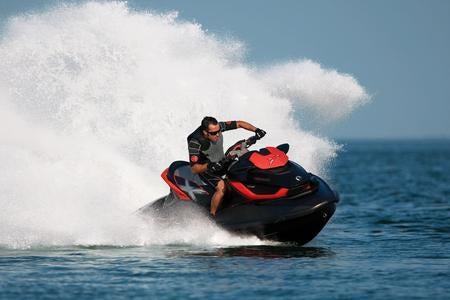
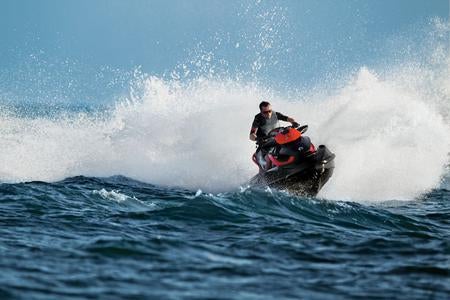
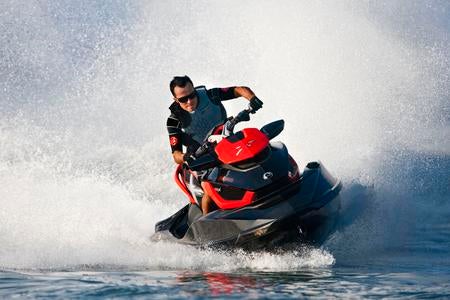
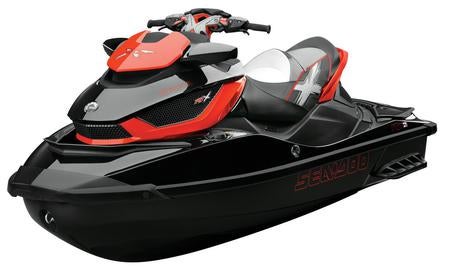







 Your Privacy Choices
Your Privacy Choices